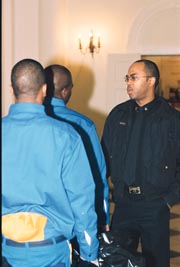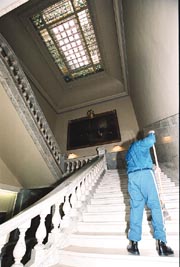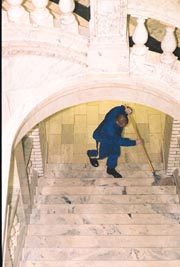Blue and Gold
In a New Light
By Carolyn Lee
In this town,
one could say that uniforms are ubiquitous. We usually associate
the crisp white or navy blue uniforms---depending on the season
or the occasion---with the midshipmen of the Naval Academy. But
there are other uniforms you're likely to see in Annapolis, worn
by the young men working in and around the State House and the
Governor's Mansion. Their uniforms are bright blue and gold, the
colors of the Maryland Division of Correction, and they're worn
by the inmates of the Herman L. Toulson Correctional Boot Camp,
otherwise known as "boot campers."
 According
to Cmdr. Brenda M. Shell, "The uniforms represent the boot camp
as a distinct entity within the Division of Correction. [The use
of uniforms] limits individuality and makes everyone an equal.
It also makes a person easy to identify." According
to Cmdr. Brenda M. Shell, "The uniforms represent the boot camp
as a distinct entity within the Division of Correction. [The use
of uniforms] limits individuality and makes everyone an equal.
It also makes a person easy to identify."
The boot campers, in this setting, are a privileged group of young
men who have been chosen for the State House "detail." Says Custody
Manager Maj. Carroll Parrish, "All of the guys who work at the
State House are non-violent offenders. In the first phase of their
training, they go through a Marine Corps-style boot camp with
intense instruction and supervision to help them develop self-discipline.
After that, we select the best inmates of the group and send those
men to Annapolis. We also select the best officers to accompany
them."
The State House detail is composed of 10 to 12 men. The staff
of the Department of General Services assigns a certain number
to work on the grounds of the State House, where their responsibilities
include shoveling snow or raking leaves or assisting in general
cleanup and landscaping. Inside the State House, other inmates
are supervised by a corrections officer. Two more are assigned
to the Governor's Mansion and supervised by the Maryland State
Police.
 Each
weekday throughout the year, the inmates are brought to Annapolis
from Toulson Boot Camp in Jessup. "I used to take the detail down
myself," says Maj. Parrish. "We know where the inmates are at
all times and we maintain good communication with the representatives
from the Maryland State Police and the Department of General Services.
The State Police also do checks on the inmates." Asst. Cmdr. Charles
Santa explains, "Public perception is important, and public safety
is taken into consideration, first and foremost." Each
weekday throughout the year, the inmates are brought to Annapolis
from Toulson Boot Camp in Jessup. "I used to take the detail down
myself," says Maj. Parrish. "We know where the inmates are at
all times and we maintain good communication with the representatives
from the Maryland State Police and the Department of General Services.
The State Police also do checks on the inmates." Asst. Cmdr. Charles
Santa explains, "Public perception is important, and public safety
is taken into consideration, first and foremost."
The distinct blue and gold uniforms make the inmates quite visible
to the residents and tourists who enjoy walking around State Circle.
Says Maj. Parrish, "When I used to take details down to the State
House, we would march through the building and the tourists would
say, 'Who are those men? What branch of the service are they in?'
They were very surprised to hear my reply." He adds, "The guys
are motivated because they're being productive. They feel good
about being at the State House and sometimes get to meet public
officials." Maj. Parrish recalls when one of the inmates met a
delegate on the State House elevator and ended up inviting him
to graduation.
 Although
there are women in the boot camper program, the heavy work of
the State House detail precludes their participation. The inmates
are often assigned to do some of the more onerous tasks at the
State House. Large, cumbersome pieces of furniture must be moved
in and out, often without the benefit of an elevator---and there's
always lots of brass to polish. Says Cmdr. Shell, "Believe it
or not, we get lots of requests [for their help.] It's hard for
us to keep up with the demand." Although
there are women in the boot camper program, the heavy work of
the State House detail precludes their participation. The inmates
are often assigned to do some of the more onerous tasks at the
State House. Large, cumbersome pieces of furniture must be moved
in and out, often without the benefit of an elevator---and there's
always lots of brass to polish. Says Cmdr. Shell, "Believe it
or not, we get lots of requests [for their help.] It's hard for
us to keep up with the demand."
Recently, the 5th Regiment Armory Maryland National Guard observed
the boot campers at the State House and requested a detail for
their own facility. When you're driving on the highway, you may
see both male and female inmates doing cleanup for the State Highway
Administration. You may also see them helping to prepare for baseball
season at Camden Yards, at the annual Polar Bear Plunge, the Annapolis
Seafood Festival, the Blues Festival, and at Maryland Special
Olympics.
 If
all this sounds like casual work, we are reminded that these young
boot camp inmates (average age is from 22-24 years old) train
16 hours a day for 180 days. Every waking hour is utilized in
a productive manner, with no idle time, no recreational television,
radios, newspapers or magazines. A typical day begins with a 5
a.m. wake-up, followed by breakfast, sick call, clean-up, physical
training, and barracks inspection. By the time the boot campers
arrive in Annapolis or at their other details, they've been up
for hours. If
all this sounds like casual work, we are reminded that these young
boot camp inmates (average age is from 22-24 years old) train
16 hours a day for 180 days. Every waking hour is utilized in
a productive manner, with no idle time, no recreational television,
radios, newspapers or magazines. A typical day begins with a 5
a.m. wake-up, followed by breakfast, sick call, clean-up, physical
training, and barracks inspection. By the time the boot campers
arrive in Annapolis or at their other details, they've been up
for hours.
Toulson Boot Camp is regarded as one of the very best in the country.
It is commanded by a woman, well-qualified by her master's degree
in criminal justice (with plans to complete her juris doctor degree)
and by her personal experience as "mom, grandmother and foster
mom."
Shell describes the boot campers program in her characteristic
gentle, understated manner. " In August 1990, Gov. William Donald
Schaefer officially dedicated the boot camp." Developed with the
objective of making it the best unit of its kind in America, she
says, "The boot camp was designed to be an alternative to incarceration."
Social workers, along with substance abuse authorities from the
Division of Correction developed the counseling and substance
abuse aspects of the program while educational staff from the
Division of the Maryland Department of Education worked together
to devise the educational aspects of the program.
Correctional officers were hand picked to staff the new boot camp.
All had superior service records with the Division of Correction
and nearly all were former U.S. Marines or had served with other
branches of the armed services. The United State Marine Corps
provided intensive training to the initial group of drill instructors
at its Officer's Candidate School in Quantico, Va.
The boot camp program has three goals. The first is to help alleviate
prison overcrowding. This is accomplished by providing the means
for selected inmates to be released after completion of six months
of intensive incarceration experience.
The second goal is to encourage inmates to become responsible,
productive citizens and to provide them with the necessary resources
to do so. The boot camp is designed to be a positive environment
for human development where individuals can help themselves and
each other. It uses a strict physical and military regimen for
the purpose of keeping inmates motivated and focused on making
behavioral changes and confronting attitudes which are destructive.
The third goal is to create a more positive environment for both
inmates and the correctional employees who operate the boot camp.
Toulson Boot Camp is a non-contact program where employees lead
by personal example and act as role models and mentors to the
inmate population.
 In order to graduate from the boot camp, all inmates must successfully
complete programs in military drill; physical training; academic
education, with a focus on helping inmates obtain a General Educational
Development (GED) certificate, and providing special education
services to those who qualify; "Network," a problem solving and
decisionmaking program; addiction education; and skills training.
In order to graduate from the boot camp, all inmates must successfully
complete programs in military drill; physical training; academic
education, with a focus on helping inmates obtain a General Educational
Development (GED) certificate, and providing special education
services to those who qualify; "Network," a problem solving and
decisionmaking program; addiction education; and skills training.
According to Shell, "[Toulson Boot Camp] is a leader of boot camps
in the nation because of the well-balanced structure it provides.
A lot of boot camps focus primarily on the military structure
with an emphasis on physical activity. At this boot camp, we balance
that structure with other aspects of programming. A very important
piece is the GED program. The success rate is extremely high,
with a significant number of inmates achieving their GED upon
completion of the program."
In addition to the GED program, Toulson Boot Camp provides college
courses in psychology and history---even an eight-week certificate
course in fiber-optics for those who have already attained a high
school diploma or GED. The courses are taught on site in partnership
with Anne Arundel Community College, which provides instructors,
certificates of completion and job placement for those inmates
who complete the courses. With a sense of pride, Cmdr. Shell mentions
that "at least one ex-inmate went on to become an instructor at
Anne Arundel Community College."
For the inmates unable to achieve their GED, the boot camp offers
a certificate in life skills. Says Shell, "Most of the inmates
come into the program at an educational level that is raised by
at least two [levels] in a six-month period." Educators from the
State Department of Education provide inmates with instruction
in basic computer skills, parenting and job readiness.
In addition, avocational instruction in building construction
skills is offered, including hands-on training in carpentry, electrical
work, even some plumbing and HVAC. The results? What started as
a storage shed constructed by the inmates is being converted into
additional classroom space. Says Shell, "this program has enabled
the Department of Public Safety and Correctional Services to save
about $2.5 million. We've gone on site to do work and repairs
for the Division of Pre-Trial Detention and Services, done building
projects for the supermax facility, the Maryland State Police
and home detention---and the list goes on."
The Herman L. Toulson Correctional Boot Camp has aroused interest
in its program model from as far away as Denmark. Closer to home,
Cmdr. Shell is pursuing a partnership with Baltimore City on a
transitional jobs project. Says Sister Gwynette Proctor, who heads
the project for the city, "I was impressed immediately with Cmdr.
Shell's vision for the men and women who come through the boot
camp. She sees beyond institutional confinement and has a dream
for them. People like her are an essential link in the process.
She knows the wisdom of such an effort."
Cmdr. Shell might measure the success of the program in this way:
"I see the individuals who leave here worshiping in my church.
These men and women are going home.
Back
|

